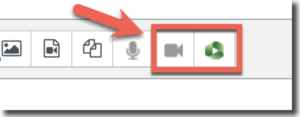Capture the Energy: 5 Tips for the Beginning of the Semester

I’ve been an educator for over 20 years and have had the “first-day” experience more than 100 times, yet the first day of the new semester always brings forth nervous energy. I’m energized by the fresh opportunity to start on the right foot and the unknown potential of the students before me. So, I am going to share some practical things you can do at the beginning of the semester to capture that energy and set a course up for success.
These tips will center around the successful beginning of semester themes from The Online Teaching Survival Guide: Simple and Practical Pedagogical Tips by Judith Boettcher and Rita-Marie Conrad → presence, community, clear expectations, patience, and energy (2021, p. 80). Although this book is about online teaching, these focus themes are also key in successfully launching a blended or face-to-face course. So, read on to find practical tips and digital tools to start your semester.
1. Cognitive Presence: There are many ways to think of instructor presence in a class. Try modeling “cognitive presence” for students by demonstrating how they can interact with your content. Draw connections for students and give examples of quality posts in forums, thorough responses to questions, and so on when helping students connect to course content. This type of presence will help students understand the “why” of your course. Talk through how you would take notes, read a text, watch a course video, etc., in a live class or short video to model how students can succeed with your content. This modeling also helps them know how to participate and what kind of work quality you are looking for when grading them.
- Tool to Try → Panopto: Make a quick video using Panopto Capture to create the walk-through content model for students.
2. Energy: Your passion and energy can be infectious for students —even if sometimes you have to fake it ‘till you make it! Share your energy with students — excitement, knowledge, curiosity, and questions to help learners capture your energy and then (hopefully) motivation. Maintain this energy for yourself by planning emotionally for your classes, not just planning a lesson or lecture. If you are teaching face-to-face, give yourself pre-game time to get energized for class topics and student interactions. If you teach online, allow some of your feedback or short in-the-moment video announcements to be an opportunity to share with students what excites you about class.
- Tool to Try → Videos within Moodle Announcements: use the video button or Panopto button in course announcements to make a quick, authentic video

3. Community: Moving forward from having a presence with your students, you can continue working to build community in your class. Can you use surveys or discussions to find out what experiences and views of your content students already have? It can be helpful to use discussion forums, live class discussions, a Zoom session, or another chat format to help students build “a sense of shared understandings, knowledge of one another, and mutual support” (Boettcher & Conrad, 2021, P. 82). Consider starting with questions in which students share their favorite foods, books, movies, etc., to get them going and then move into sharing their learning habits and perspectives on the course content. Typically we need to know a bit about others before we feel comfortable beingvulnerable about ourselves.
- Tools to Try → Moodle Feedback and Moodle Chat: Moodle feedback is a non-graded survey tool built into Moodle and Chat that allows for an online real-time synchronous discussion. Moodle Chat can be used during class as a backchannel to help more students feel comfortable participating or during a hybrid class to connect online and in-class students.
4. Clear Expectations & Early Feedback: Students want to know what is expected of them. The modeling you do as part of creating cognitive presence can make a difference in creating clear expectations. Suppose you plan to ask students to regularly participate in discussion boards, create concept maps, make videos, take online quizzes, etc. Add a practice or lower-stakes version of these formats early in the class to build their comfort level. Give feedback on these early assignments, possibly even more than you will provide later in the semester, to enhance students’ understanding of what you expect. Integrate an activity that helps students actively engage with your expectations. For example, if you include your expectations in a syllabus, can students do a scavenger hunt through your syllabus or write a forum post in which they share their own custom learning goals based on the syllabus? If you need to nudge students as the semester goes forward, you can reference the goals they set for themselves.
- Tools to Try → Question and Answer Forum or Google Form: Ask students to set goals for themselves in your course using specifics from the syllabus (or other course resources you use to share expectations). In the Q&A forum type, students must answer before seeing other students’ responses. When their peer responses open up, it can be helpful to know that they have similar goals. If students submit their goals using a Google Form, you can enable the setting to email students a copy of their responses.
5. Patience: Sometimes, our beginning of the semester energy can be thwarted if students don’t reciprocate in the way we hope or expect them to. Try to remember that we don’t always know what life experiences and academic experiences students have had. Students may not be ready to take on the responsibility we hope for. Consider using some tools in Moodle to help students with their self-regulation and executive functioning that lead to goal setting and being successful in courses.
- Tools to Try → Roadmap or Checklist: These Moodle tools help students manage their progress through a course or sections of a course.
After an initial couple of weeks, as you move into the “early middle” part of the course, establish a rhythm to help students succeed. Maintain consistent tools and the same activity types you modeled for students at the beginning of the semester. When you want to check on student progress and send them feedback, IntelliBoard can provide excellent analytics on student success and where students might be struggling. See how data can inform your connection with students!
Resources
Boettcher, J.V. & Conrad, R. (2021). The online teaching survival guide : Simple and practical pedagogical pips: Third edition. Jossey-Bass. https://catalog.lib.ncsu.edu/catalog/NCSU5279207
Shadiow, L. (2019, January 21). The rhythms of the semester: Implications for practice. Faculty Focus: Higher Ed Teaching & Learning https://www.facultyfocus.com/articles/philosophy-of-teaching/the-rhythms-of-the-semester-implications-for-practice-persona/
Shea, C. (2021, January 8). This semester, don’t forget participation feedback! Faculty Focus Higher Ed Teaching & Learning. https://www.facultyfocus.com/articles/online-education/online-assessment-grading-and-feedback/this-semester-dont-forget-participation-feedback/


